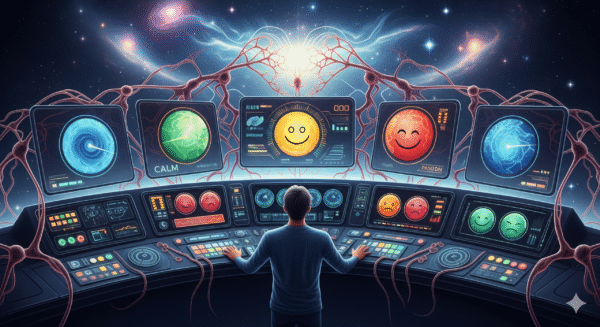Understanding Your Emotional Dashboard Signals.
,%20showing%20a%20person%20intently%20looking%20at%20it)
1. The Brain as a Control Center: A Sophisticated System
Before diving into the dashboard, let’s briefly understand the “vehicle.” Your brain, weighing about three pounds, is an astonishingly complex organ. It’s the central processing unit for everything you think, feel, and do. It manages countless bodily functions, processes sensory input, stores memories, and orchestrates your personality. To do all this effectively, it needs a sophisticated feedback system – and that’s where emotions come in.
1.1. Beyond Simple Reactions: The Biology of Emotion
Emotions aren’t just ‘feelings.’ They are complex physiological and psychological responses involving various brain regions (like the amygdala, prefrontal cortex, hippocampus) and neurochemicals (such as dopamine, serotonin, cortisol). When you feel an emotion, your brain is signaling a shift in your internal state or a response to something external. This is a survival mechanism, refined over millions of years of evolution.
2. Emotions as Your Dashboard: Real-Time Feedback Systems
Think of your car’s dashboard. It has lights for engine temperature, fuel level, battery charge, and speed. Each light tells you something specific and important. Your emotional dashboard works in much the same way, providing critical data points about your current situation.
2.1. Joy: The ‘Optimal Performance’ Indicator
- Signal: You’re thriving, connecting, achieving, or experiencing pleasure.
- Message: “Keep doing this! This is good for you. You’re in alignment with your values or experiencing something beneficial.”
- Action: Reinforces positive behaviors, strengthens relationships, encourages engagement.
2.2. Anger: The ‘Boundary Violation’ or ‘Injustice’ Alert
- Signal: A boundary has been crossed, a perceived injustice has occurred, or your values are being violated.
- Message: “Something is wrong here. Your rights or needs are being ignored. Take action to protect yourself or rectify the situation.”
- Action: Motivates self-protection, assertion, problem-solving, or seeking fairness.
2.3. Sadness: The ‘Loss’ or ‘Need for Comfort’ Light
- Signal: You’ve experienced a loss (person, opportunity, dream) or a significant disappointment.
- Message: “Slow down. Process this loss. Seek comfort and connection. Let go of what’s no longer serving you.”
- Action: Encourages reflection, self-care, seeking support, and healing.
2.4. Fear/Anxiety: The ‘Threat Ahead’ Warning
- Signal: A perceived threat, danger, or uncertainty is present.
- Message: “Be cautious. Assess the situation. Prepare for potential danger or problem-solve for uncertainty.”
- Action: Triggers fight, flight, freeze response; promotes careful planning, risk assessment.
2.5. Disgust: The ‘Avoid Harm’ Signal
- Signal: Something is potentially toxic, harmful, or morally reprehensible.
- Message: “Stay away. Protect yourself from this contamination (physical or moral).”
- Action: Promotes avoidance of harmful substances or situations; moral judgment.
2.6. Surprise: The ‘Attention Required’ Blink
- Signal: Something unexpected has happened.
- Message: “Pay attention! This is new information. Reorient yourself.”
- Action: Focuses attention, allows for rapid adjustment to new circumstances.
Every emotion serves a purpose, guiding us towards survival, well-being, and growth.
3. The Importance of Emotional Literacy: Reading Your Dials
Just like a pilot needs to understand every gauge in a cockpit, we need emotional literacy – the ability to understand, express, and manage our emotions – to navigate life effectively. This isn’t about controlling emotions, but understanding their messages.
3.1. Identifying and Naming Emotions Accurately
- Beyond “Good” or “Bad”: Emotions are data, not moral judgments. Labeling them accurately (e.g., “I feel frustrated” instead of “I feel bad”) provides clearer information.
- Expanding Your Emotional Vocabulary: The more words you have for emotions, the more precisely you can identify what you’re feeling and why.
3.2. Listening to the Message, Not Just the Feeling
When an emotion arises, instead of reacting immediately, pause and ask:
- “What is this emotion telling me?”
- “What underlying need is unmet?”
- “What boundary has been crossed, or what opportunity is present?”
For example, anxiety about a presentation might be a signal to prepare more thoroughly, not just to panic.
3.3. Differentiating Primary from Secondary Emotions
Sometimes, we feel a “secondary” emotion that masks a “primary” one. For instance, anger might be a secondary emotion, covering deeper feelings of hurt or sadness. Learning to dig a little deeper helps address the root cause.

4. Misinterpreting the Dashboard: When Emotions Go Awry
Just as a faulty sensor can give a false reading, our emotional dashboard can sometimes mislead us. This can happen due to past trauma, unhealthy coping mechanisms, or a lack of emotional training.
4.1. Overwhelming Emotions: A Dashboard in Overdrive
When emotions are too intense or persistent, it can feel like the entire dashboard is flashing red. This can lead to:
- Emotional Dysregulation: Difficulty managing and responding to emotional experiences in a healthy way.
- Burnout: Chronic stress and unaddressed emotions can lead to mental and physical exhaustion.
- Maladaptive Coping: Turning to unhealthy habits (e.g., substance abuse, avoidance) to numb or escape feelings.
4.2. Suppressing Emotions: Ignoring the Warning Lights
Ignoring emotions doesn’t make them disappear. Instead, they often manifest in other ways:
- Physical Symptoms: Headaches, digestive issues, chronic pain.
- Explosive Outbursts: Emotions eventually erupt due to suppression.
- Relational Problems: Inability to connect authentically due to emotional distance.
4.3. Externalizing Blame: Misreading the Source
Sometimes, instead of looking inward at what an emotion is telling us, we blame external factors or other people. This prevents us from taking responsibility and finding true solutions.
5. Mastering Your Dashboard: Strategies for Emotional Intelligence
Developing emotional intelligence (EQ) is like learning to drive your life’s vehicle skillfully. It involves understanding and managing your own emotions, and recognizing and influencing the emotions of others.
5.1. Cultivating Self-Awareness (Reading Your Own Dials)
- Practice Mindfulness: Regularly observe your thoughts and feelings without judgment. Meditation and body scans are excellent tools.
- Journaling: Write down what you’re feeling and why. This helps process emotions and identify patterns.
- Check-in Regularly: Take moments throughout the day to ask, “How am I feeling right now?” and “What do I need?”
5.2. Developing Self-Regulation (Adjusting Your Controls)
- Pause Before Reacting: Create a space between emotion and response. Take a deep breath.
- Cognitive Reappraisal: Challenge negative thoughts. Ask, “Is there another way to look at this situation?”
- Stress Management Techniques: Exercise, deep breathing, spending time in nature, pursuing hobbies.
- Healthy Coping Skills: Develop constructive ways to deal with difficult emotions, like talking to a friend, exercising, or engaging in a creative outlet.
5.3. Harnessing Empathy (Understanding Other Dashboards)
- Active Listening: Truly listen to understand others’ perspectives and feelings, even when they differ from yours.
- Perspective-Taking: Try to see situations from another person’s point of view.
- Observing Non-Verbal Cues: Pay attention to body language, tone of voice, and facial expressions.
5.4. Building Relationship Management (Navigating with Others)
- Effective Communication: Express your needs and feelings clearly and respectfully.
- Conflict Resolution: Learn constructive ways to address disagreements.
- Setting Healthy Boundaries: Protect your emotional well-being by defining what is and isn’t acceptable in your relationships.
6. The Benefits of a Well-Maintained Emotional Dashboard
Investing in your emotional intelligence yields profound rewards, leading to a richer, more meaningful life.
6.1. Improved Decision-Making
When you understand your emotions, you can make decisions that are not just logical but also aligned with your values and well-being. Emotions provide crucial intuitive data that logic alone might miss.
6.2. Stronger Relationships
Emotional literacy helps you understand both yourself and others better, leading to deeper empathy, more effective communication, and more resilient relationships.
6.3. Greater Resilience
By learning to process and regulate emotions, you become more adaptable and able to bounce back from setbacks and challenges. You learn to navigate life’s storms with greater strength.
6.4. Enhanced Physical Health
Chronic stress and unaddressed emotions can take a toll on your body. Emotional well-being is intrinsically linked to physical health, reducing stress-related illnesses and promoting overall vitality.
6.5. A More Fulfilling Life
When you’re in tune with your emotional dashboard, you live more authentically. You pursue goals that genuinely motivate you and avoid situations that drain you, leading to greater contentment and purpose.
7. Conclusion: Your Emotions as a Guide to a Purposeful Life
The analogy of emotions as the brain’s dashboard is more than just a metaphor; it’s a powerful framework for understanding our deepest selves. Every feeling, whether pleasant or uncomfortable, is a message, a piece of vital data meant to guide us. By cultivating emotional literacy and intelligence, we learn to read these signals with precision, address underlying issues, and navigate the complex journey of life with greater skill and awareness.
Don’t ignore the flashing lights or the subtle hums of your emotional dashboard. Instead, pause, listen, and interpret. Your emotions are not obstacles; they are your most reliable guides, leading you toward self-understanding, healthier relationships, and a life lived with intentionality and profound well-being. Embrace the wisdom of your feelings, and unlock the full potential of your incredible inner navigation system.
Share Your Experience:
How do you interpret your emotional dashboard? What emotions do you find most challenging or most insightful? Share your thoughts and strategies in the comments below!




Pingback: Love, Health, And Happiness: Unlocking The True Secret To A Fulfilling Life In 2025 - LOVE AND HEALTH FUTURE
Nice response in return of this query with firm arguments and describing everything concerning that.
Greetings, I think your website could possibly be having web browser compatibility problems.
When I look at your site in Safari, it looks fine however when opening in Internet Explorer, it’s got some overlapping issues.
I just wanted to give you a quick heads up!
Apart from that, excellent blog!
hello!,I love your writing very a lot! percentage we keep
up a correspondence extra about your article on AOL?
I need a specialist on this house to resolve my problem. May
be that is you! Having a look ahead to see you.
Hi my loved one! I want to say that this article is awesome, great written and include approximately all vital infos.
I’d like to see more posts like this .
Thanks a lot.
You actuаlly make it seem so easʏ with your presentation but I find this topioc to be really something whіch I think I wοuld
never understand. It seems too complex and extremely brtoad forr me.
I’m lo᧐iҝing forward for your next post, I’ll try too get
the hang of it!
My web-site :: slope game